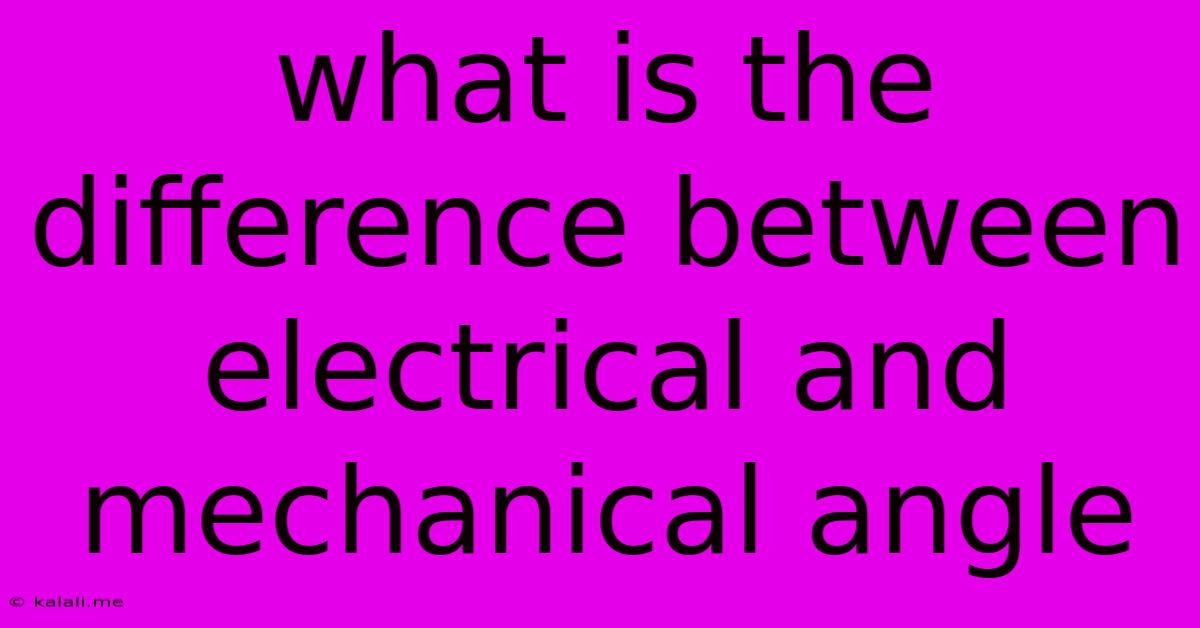What Is The Difference Between Electrical And Mechanical Angle
Kalali
Jun 04, 2025 · 3 min read

Table of Contents
Understanding the Difference Between Electrical and Mechanical Angle in Motors
This article delves into the crucial distinction between electrical and mechanical angles, particularly within the context of rotating electrical machines like motors and generators. Understanding this difference is fundamental to comprehending how these machines operate and their performance characteristics. This detailed explanation will cover the basics and provide practical examples to solidify your understanding.
What is Mechanical Angle?
The mechanical angle refers to the physical rotation of the rotor within a motor or generator. It's a straightforward concept: a full rotation of the rotor represents a 360-degree mechanical angle. This angle is directly measurable using physical means, such as a protractor or an encoder attached to the motor shaft. Think of it as the actual, tangible rotation of the physical components.
What is Electrical Angle?
The electrical angle, on the other hand, is a representation of the relative position of the magnetic fields within the machine. It's not directly observable like the mechanical angle; instead, it's derived from the number of poles in the motor or generator. A complete cycle of the electrical waveform produced by the motor or generator corresponds to a 360-degree electrical angle.
The Key Difference and Relationship
The core difference lies in the fact that the electrical angle is often a multiple of the mechanical angle. The relationship is directly proportional to the number of poles (P) in the machine:
- Electrical Angle = (P/2) * Mechanical Angle
This means:
- In a 2-pole motor (P=2): The electrical and mechanical angles are identical. One complete mechanical rotation (360°) equals one complete electrical cycle (360°).
- In a 4-pole motor (P=4): A single mechanical rotation (360°) corresponds to two complete electrical cycles (720°). This is because the magnetic field completes two cycles during one mechanical revolution.
- In an 8-pole motor (P=8): One mechanical rotation (360°) results in four complete electrical cycles (1440°).
Practical Implications and Examples
This difference has significant implications for motor control and understanding AC waveforms.
- Synchronous Motors: The relationship between electrical and mechanical angles is crucial in understanding the synchronous speed of a motor. The synchronous speed is determined by the frequency of the AC power supply and the number of poles.
- AC Waveform Generation: The electrical angle is essential when analyzing the sinusoidal waveforms generated by alternators (generators). Each pole pair contributes to a single cycle in the generated waveform.
- Stepper Motors: Stepper motors use the concept of electrical angles to control precise rotational movements in increments. Each step corresponds to a specific electrical angle change.
In Summary
While the mechanical angle represents the physical rotation of the motor shaft, the electrical angle represents the relative position of the magnetic fields, which is influenced by the number of poles. Understanding this distinction is vital for anyone working with or studying rotating electrical machines, enabling more accurate analysis, control, and design. The relationship between the two angles – directly proportional to the number of poles – allows for precise calculation and prediction of motor behavior and power generation characteristics. This difference affects various applications, from synchronous motor operation to the precise control offered by stepper motors.
Latest Posts
Latest Posts
-
Can You Water Plants With Distilled Water
Jun 05, 2025
-
Connection Closed By Authenticating User Preauth
Jun 05, 2025
-
How To Calculate Passive Perception 5e
Jun 05, 2025
-
How To Care For An Avocado Tree
Jun 05, 2025
-
Bedromm Get Smelly If Stay Foe Long
Jun 05, 2025
Related Post
Thank you for visiting our website which covers about What Is The Difference Between Electrical And Mechanical Angle . We hope the information provided has been useful to you. Feel free to contact us if you have any questions or need further assistance. See you next time and don't miss to bookmark.